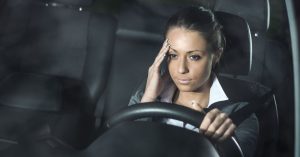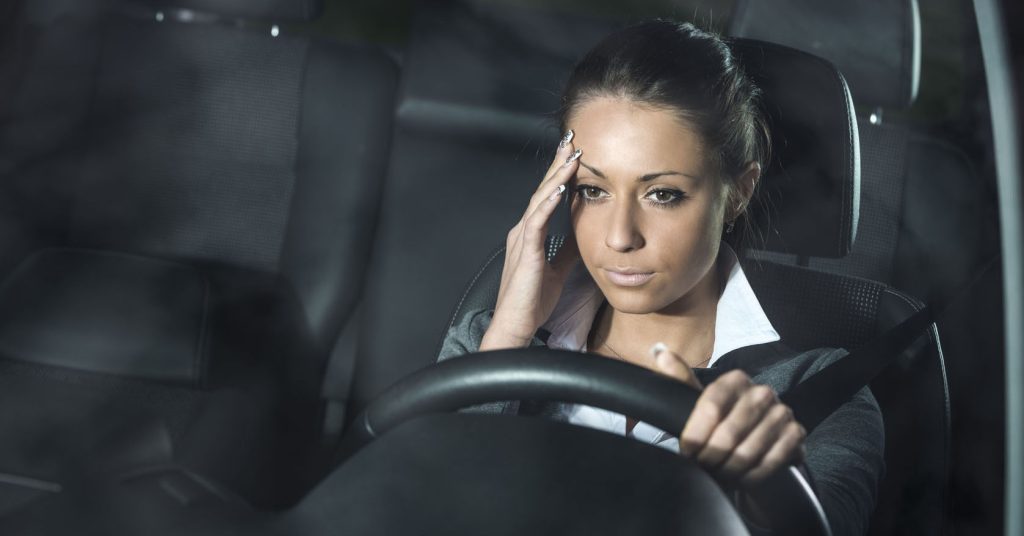Posts Tagged ‘“car crash”’
Parents: Does Your College Student Think Drowsy Driving is Dangerous?

A new study shows college students are engaging in drowsy driving and do not consider it to be as dangerous as texting while driving and operating under the influence.
As a parent, you have probably talked to your college student about the risks of drunk driving and texting while driving on many occasions. What about drowsy driving? A new study reports college students are not taking this risk as seriously – even as drowsy driving causes an estimated 300,000 traffic crashes each year in the U.S.
The study was published in the February edition of the journal Sleep Health. Researchers conducted four focus groups involving 26 undergraduate students in 2016. Students were asked about their driving behaviors and perceptions about dangerous driving.
Most of the students considered themselves safe drivers, yet they viewed drowsy driving as less risky than operating under the influence of alcohol and distracted driving. Students actually said drowsy driving was “normal” and an “unavoidable part of their lives.” They admitted to drowsy driving in the past. Whether as a driver or passenger, many had actually been in some way involved in a drowsy driving car crash or near accident. In most cases, students were driving alone in the early morning or at night.
Attorney Marc Breakstone Interviewed by Fox 25 TV About Accident Reconstruction in Crash that Killed State Trooper
Fox 25 TV has reported the driver who hit and killed a Massachusetts state trooper has left the hospital. He is scheduled to appear in court and be criminally charged, but has not been formally charged yet.
David Njuguna, 30, of Webster, is expected to appear in Dudley District Court in about a month and be formally charged with negligent operation of a motor vehicle, failure to stay within marked lanes and speeding, State Police told the news station. He is currently out free without court bail conditions, though his driver’s license has been revoked.
 Fox 25 TV asked Attorney Marc Breakstone, who has represented car accident victims in Massachusetts for 30 years, why criminal charges have not been filed already.
Fox 25 TV asked Attorney Marc Breakstone, who has represented car accident victims in Massachusetts for 30 years, why criminal charges have not been filed already.
Breakstone said State Police have a defined process for handling accident reconstructions and are following it.
“These are to be considered preliminary charges until the state reconstruction team completes its analysis, issues its determination whether or not negligence was involved in the death of this officer,” Breakstone said.
Additional charges may be filed after the accident reconstruction is complete.
Earlier this month, Njuguna’s car reportedly veered across three lanes of traffic at a high rate of speed on the Massachusetts Turnpike in Charlton, hitting and killing State Trooper Thomas Clardy, who was in the breakdown lane making a traffic stop. Clardy, a 44-year-old father of four, had been a state trooper since 2005.
Njuguna, 30, was injured in the car crash and transported to UMass Memorial Medical Center in Worcester. He suffered a concussion, two broken wrists and a thigh wound in the crash, according to The Boston Globe. Relatives later told a Globe reporter he had no memory of the crash.
Fox 25 TV reported sources said investigators are looking at the possibility that Njuguna intentionally hit the State Police officer’s cruiser.
Breakstone said that would be hard to prove.
“If there is evidence from the state police reconstruction analysis that this was an intentional act he may be charged with murder,” he said.
About Breakstone, White & Gluck
The Boston personal injury attorneys at Breakstone, White & Gluck have over 100 years combined experience handling motor vehicle accident cases resulting in serious personal injury or wrongful death. If you have been injured, it is important to learn your rights. For a free legal consultation, contact us at 800-379-1244 or 617-723-7676 or use our contact form.
Buckle Up Massachusetts: State Fails to Win Top Safety Score from Watchdog Organization
 When it comes to seat belts, Massachusetts may need to buckle up and strengthen its laws if it wants a higher rating from one safety organization.
When it comes to seat belts, Massachusetts may need to buckle up and strengthen its laws if it wants a higher rating from one safety organization.
Massachusetts was among 29 states which received a secondary rating from the Advocates for Highway & Auto Safety in its annual report released in January. In the 2014 “Roadmap of State Highway Safety Laws” report, the group gave 10 states – including Rhode Island – its highest rating. Poor ratings were given to New Hampshire and 10 other states.
Massachusetts received strong marks for teen driving laws, but fell short in other areas, including its lack of a primary seat belt law.
In Massachusetts, the law governing seat belt use is M.G.L. c. 90 § 13A. Drivers and passengers are required to wear seat belts, but police can only issue citations for violations if they pull over a vehicle for another offense. Each driver and occupant over age 16 shall be fined $25 for failing to wear a seat belt. Drivers can be fined for occupants 12 to 16 years old. Children 12 and younger must follow the Massachusetts Child Passenger Safety Law, M.G.L. c. 90, §7AA.
Across the country, 33 states and the District of Columbia have primary enforcement laws for front seat passengers and 17 have these laws for back seat passengers.
The National Highway Traffic Safety Administration (NHTSA) has long cited seat belts as the most effective way to reduce the risk of death in a car crash. In 2012, the agency credits seat belts with saving 12,174 lives in auto accidents.
In Massachusetts, we have fiercely debated our seat belt laws. Gov. Michael Dukakis signed a mandatory seat belt law in 1985. But a year later, opponents organized a citizen campaign and repealed the measure at the ballot box.
While today’s law requires drivers and passengers to wear seat belts, in 2009 the NHTSA surveyed seat belt use across the country and ranked Massachusetts last for compliance.
At that time, 67 percent of occupants of vehicles in Massachusetts were wearing seat belts compared to the national average of 83 percent among other states.
Recent state figures report a greater compliance rate. The 2012 Massachusetts Safety Belt Usage Observation Study, prepared for Massachusetts Highway Safety Division reported a 73 percent compliance rate in 2011, an increase from 50 percent in 2000.
Attorney Ronald Gluck of Breakstone, White and Gluck stated that “fortunately, over the years, our firm has seen a significant reduction in cases where the injuries are directly tied to the failure of occupants to wear seat belts. ”
Related:
2014 Roadmap of Highway Safety Laws, Advocates for Highway & Auto Safety.
2012 Massachusetts Safety Belt Observation Study, Massachusetts Highway Safety Division.
Read More
Big Dig Handrails Under Scrutiny After Massachusetts Drivers’ Deaths
Lawmakers and individuals are calling for change after seven deadly Big Dig crashes have been linked to handrails in the tunnels. State Senate President Therese Murphy has requested that the Department of Transportation, which overseas the tunnel system, review the handrails’ design and safety. Between 2004 and 2008, seven of the nine fatal accidents in the Big Dig were the result of vehicles hitting the handrails. Most crash victims were dismembered. The handrails line about six miles of the Big Dig on elevated walkways and are designed to prevent workers from tumbling into traffic.
The handrails are also the subject of litigation in Suffolk Superior Court. The widow of State Trooper Vincent Cila, who was killed after hitting a handrail post while on a motorcycle in 2005, has filed a wrongful death suit against multiple parties, including the state Turnpike Authority. The defendants assert that the handrails meet all applicable safety standards and regulations.
Despite assertions to the handrails’ safety, relatives and friends of crash victims are calling for the handrail design to be changed. Experts consulted by the Boston Globe said that the handrails are flawed. The horizontal rails are spaced far apart, allowing motorists to become entangled, and the rails are only three feet above the road, at head level. However, handrail design may not be solely to blame for the grisly crashes. Many of the drivers killed were speeding or not wearing seatbelts.
For assistance with a motor vehicle accident, truck accident, or wrongful death case, please contact the attorneys at the Boston law firm of Breakstone, White and Gluck. The lawyers have over 80 years of experience with litigating in state and federal court, at the trial and appellate level. To consult with an experienced attorney, call 800 379 1244 or visit the firm’s website.
Toyota Recall of Defective Cars to Affect 3.8 Million Vehicles–Floor Mats Blamed for Crashes
In what will be the largest recall in the history of Toyota Motor Corp., the company will be recalling 3.8 million defective motor vehicles because of defective floor mats. The defective mats may cause the accelerator to jam, and may lead to serious accident.
Toyota has recommended that for several Camry, Avalon, Prius, Tacoma, Tundra and Lexus models the driver’s side removable mat be removed from the car immediately and not replaced until the company issues a fix.
According to the Washington Post, Transportation Secretary Ray LaHood has called this an “urgent matter,” and has strongly urged owners to “remove mats and other obstacles that could lead to unintended acceleration.”
One recent spectacular car crash has been blamed on the defective mats. In August 2009, a California family was traveling in a 2009 Lexus ES 350 when the car’s accelerator became stuck. The runaway vehicle could not be stopped, and reached a speed of 120 mph before crashing, rolling off the highway, and catching fire. All four family members were killed.
Toyota has also issued instructions on how to disable the vehicle if the accelerator becomes jammed. A driver should use both feet on the brake to slow the car and slip the gear shift into neutral. The key should be turned to accessory (not to lock, otherwise steering will be lost). In a push-button ignition, holding the button for three seconds will kill the engine.
More Information
For more information, consumers can contact the National Highway Traffic Safety
Administration’s hotline at (888) 327-4236, Toyota at (800) 331-4331 or Lexus at
(800) 255-3987.
Toyota to recall 3.8M vehicles over floor mats, Washington Post, September 30, 2009.


